Diagenetic Evolution Mechanism of the Jurassic Tuffaceous Sandstone Reservoir in Qikou Sag, Bohai Bay Basin, East China
Abstract
:1. Introduction
2. Geological Background
3. Method
4. Results
4.1. Main Diagenesis
4.1.1. Mechanical Compaction
4.1.2. Authigenic Minerals
- Calcite
- 2.
- Dolomite
- 3.
- Clay Minerals
- 4.
- Quartz
4.1.3. Dissolution
4.2. Geochemical Data of Authigenic Minerals
4.2.1. Major Elements
4.2.2. Carbon and Oxygen Isotopes
4.2.3. Homogenization Temperature of Inclusions
5. Discussion
5.1. Indication of Isotopes to the Diagenetic Environment
5.1.1. The Salinity of Diagenetic Fluids
5.1.2. The Temperature of Isotope Geology
5.2. The Mechanism of Evolution of Diagenesis
5.2.1. The Mechanism of Evolution of Microcrystalline Quartz and Associated Clay Minerals
5.2.2. Mechanism of Dissolution
5.2.3. The Mechanism of Formation of Dolomite
- Early Dolomite (D1)
- 2.
- Late Ferrodolomite (D2)
5.2.4. The Mechanism of Formation of Calcite
- Ferrocalcite (C1)
- 2.
- Late Dolomite (C2)
5.2.5. Formation Mechanism of Overgrown Quartz
5.3. Sequence of Diagenetic Evolution
- The Middle-Lower Jurassic Haifanggou Formation was rich in volcanic ash. The dissolution and alteration of volcanic materials formed a highly saline and alkaline environment [50].
- The alkaline environment during deposition promoted the conversion of volcanic ash to smectite or illite/smectite mixed minerals while releasing an abundance of ions. During mineral transformation, silica-rich and illite-rich minerals were differentiated, forming illite/smectite mixed minerals and amorphous silicon.
- In the shallow burial stage (the formation temperature was about 62.3 °C), the high salinity diagenetic fluid and suitable diagenetic environment promoted the cementation of early dolomite.
- During the initial burial stage after the epidiagenetic stage, i.e., the sedimentary stage of the Shahejie Formation, several transgression events occurred, and highly saline fluid had a high biological yield under the influence of transgression. Paleontological activities generated large quantities of carbon and calcium ions. When the formation temperature reached 45.0–48.7 °C (early diagenetic stage A), the cementation of early calcite was formed.
- With the increase in the burial depth, large quantities of smectite were transformed into illite. In the process of diagenetic transformation, the enrichment of Si released promoted the transformation of amorphous silicon to microcrystalline quartz, and the released Ca, Mg, and Fe formed late dolomite at about 75 °C.
- When the burial temperature reached 80 °C, early diagenetic stage B transitioned to middle diagenetic stage A. The fluid released during the thermal evolution of organic materials was buffered by soluble components, which prevented the formation of a large acidic environment. However, the ions carried by the fluid promoted the transformation of illite to chlorite and the formation of late calcite.
- When the diagenetic temperature exceeded 100 °C, the thermocatalytic stage was reached. The thermal catalytic decarboxylation of organic matter led to the release of organic acids and CO2, which resulted in the dissolution of minerals by organic acids. The dissolved material caused the cementation of kaolinite and overgrown quartz at 116–145 °C, which was associated with the late stage of middle diagenetic stage A and the start of the transition to middle diagenetic stage B.
6. Conclusions
Author Contributions
Funding
Data Availability Statement
Conflicts of Interest
References
- Gao, Z.; Feng, J.; Cui, J.; Wang, X.; Zhou, C.; Shi, Y. Physical simulation and quantitative calculation of increased feldspar dissolution pores in deep reservoirs. Pet. Explor. Dev. 2017, 44, 359–369. [Google Scholar] [CrossRef]
- Yuan, G.; Cao, Y.; Gluyas, J.; Cao, X.; Zhang, W. Petrography, fluid-inclusion, isotope, and trace-element constraints on the origin of quartz cementation and feldspar dissolution and the associated fluid evolution in arkosic sandstones. AAPG Bull. 2018, 102, 761–792. [Google Scholar] [CrossRef]
- Yuan, G.; Cao, Y.; Qiu, L.; Chen, Z. Genetic mechanism of highquality reservoirs in Permian tight fan delta conglomerates at the northwestern margin of the Junggar Basin, northwestern China. AAPG Bull. 2017, 101, 1995–2019. [Google Scholar] [CrossRef]
- Lima, R.D.; De Ros, L.F. The role of depositional setting and diagenesis on the reservoir quality of Devonian sandstones from the Solimões Basin, Brazilian Amazonia. Mar. Pet. Geol. 2002, 19, 1047–1071. [Google Scholar] [CrossRef]
- Zhu, G.Y.; Zhang, S.C.; Chen, L.; Yang, H.J.; Yang, W.J.; Zhang, B.; Su, J. Coupling relationship between natural gas charging and deep sandstone reservoir formation: A case from the Kuqa Depression, Tarim Basin. Pet. Explor. Dev. 2009, 36, 347–357. [Google Scholar]
- Bloch, S.; Lander, R.H.; Bonnell, L. Anomalously high porosity and permeability in deeply buried sandstone reservoirs: Origin and predictability. AAPG Bull. 2002, 86, 301–328. [Google Scholar]
- Li, H.; Tang, H.M.; Qin, Q.R.; Zhou, J.L.; Qin, Z.J.; Fan, C.H.; Su, P.D.; Wang, Q.; Zhong, C. Characteristics, formation periods and genetic mechanisms of tectonic fractures in the tight gas sandstones reservoir: A case study of Xujiahe Formation in YB area, Sichuan Basin, China. J. Pet. Sci. Eng. 2019, 78, 723–735. [Google Scholar] [CrossRef]
- Susanne, G.; Richard, H.W.; William, D.J.; Hans, K. Diagenesis and reservoir quality of Miocene sandstones in the Vienna Basin, Austria. Mar. Pet. Geol. 2008, 25, 681–695. [Google Scholar]
- Islam, M.A. Diagenesis and reservoir quality of Bhuban sandstones (Neogene), Titas Gas Field, Bengal Basin, Bangladesh. J. Asian Earth Sci. 2009, 35, 89–100. [Google Scholar] [CrossRef]
- Ajdukiewicz, J.M.; Nicholson, P.H.; Esch, W.L. Prediction of deep reservoir quality using early diagenetic process models in the Jurassic Norphlet Formation, Gulf of Mexico. AAPG Bull. 2010, 94, 1189–1227. [Google Scholar] [CrossRef]
- Mansurbeg, H.; Morad, S.; Salem, A.; Marfil, R.; El-ghali, M.A.K.; Nystuen, J.P.; Caja, M.A.; Amorosi, A.; Garcia, D.; La Iglesia, A. Diagenesis and reservoir quality evolution of palaeocene deep-water, marine sandstones, the Shetland-Faroes Basin, British continental shelf(Article). Mar. Pet. Geol. 2008, 25, 514–543. [Google Scholar] [CrossRef]
- Li, H.; Zhou, J.L.; Mou, X.Y.; Guo, H.X.; Wang, X.X.; An, H.Y.; Mo, Q.W.; Long, H.Y.; Dang, C.X.; Wu, J.F.; et al. Pore structure and fractal characteristics of the marine shale of the Longmaxi Formation in the Changning Area, Southern Sichuan Basin, China. Front. Earth Sci. 2022, 10, 1018274. [Google Scholar] [CrossRef]
- Li, H. Research progress on evaluation methods and factors influencing shale brittleness: A review. Energy Rep. 2022, 8, 4344–4358. [Google Scholar] [CrossRef]
- Taylor, T.R.; Giles, M.R.; Hathon, L.A. Sandstone diagenesis and reservoir quality prediction: Models, Myths, and reality. AAPG Bull. 2020, 94, 1093–1132. [Google Scholar] [CrossRef]
- Areeq, N.M.A.; Soliman, M.A.; Essa, M.A.; Al-Azazi, N.A. Diagenesis and reservoir quality analysis in the Lower Cretaceous Qishn sandstones from Masila oilfields in the Sayun–Masila Basin, eastern Yemen. Geol. J. 2016, 51, 405–420. [Google Scholar] [CrossRef]
- French, M.W.; Worden, R.H.; Mariani, E.; Larese, R.E.; Mueller, R.R.; Kliewer, C.E. Microcrystalline Quartz Generation and the Preservation of Porosity In Sandstones: Evidence from the Upper Cretaceous of the Subhercynian Basin, Germany. J. Sediment. Res. 2012, 82, 422–434. [Google Scholar] [CrossRef]
- Worden, R.H.; French, M.W.; Mariani, E. Amorphous silica nanofilms result in growth of misoriented microcrystalline quartz cement maintaining porosity in deeply buried sandstones. Geology 2012, 40, 179–182. [Google Scholar] [CrossRef]
- Lv, Z.; Yang, X.; Qing, Y.; Ye, S. Water-rock-hydrocarbon interactions in the Middle Jurassic Shaximiao Formation sandstones, Western Sichuan. Oil Gas Geol. 2015, 36, 545–554. [Google Scholar]
- Shen, Z.; Liu, S.; Lv, Z.; Luo, X.; Gong, Y. Vertical Geochemical Characteristics of Continental Formation Water and Its Water-Rock Interaction in the Middle Area of Western Sichuan Depression. Acta Sedimentol. Sin. 2011, 29, 495–502. [Google Scholar]
- Huang, T.C. A volcanic sedimentation model: Implications of processes and responses of deep-sea ashes. Mar. Geol. 1980, 38, 103–122. [Google Scholar] [CrossRef]
- Scudder, R.P.; Murray, R.W.; Kutterolf, S.; Schindlbeck, J.C.; Underwood, M.B.; Wang, K.L. Sedimentary inputs to the nankai subduction zone: The importance of dispersed ash. Geosphere 2018, 14, 1451–1467. [Google Scholar] [CrossRef] [Green Version]
- White, R.J.; Spinelli, G.A.; Mozley, P.S.; Dunbar, N.W. Importance of volcanic glass alteration to sediment stabilization: Offshore Japan. Sedimentology 2011, 58, 1138–1154. [Google Scholar] [CrossRef]
- Khalaf, E.E.D.A.H. Diagenetic evolution of the volcaniclastic deposits: An example from neoproterozoic dokhan volcanics in wadi queih basin, central eastern desert, Egypt. Arab. J. Geosci. 2014, 7, 2603–2624. [Google Scholar] [CrossRef]
- Tari, G.; Vrsic, A.; Gumpenberger, T.; Mekonnen, E.; Enukidze, O. Eocene volcaniclastics in the kartli basin, georgia: A fractured reservoir sequence. J. Pet. Geol. 2021, 44, 413–433. [Google Scholar] [CrossRef]
- Lenhardt, N.; Götz, A.E. Volcanic settings and their reservoir potential: An outcrop analog study on the Miocene Tepoztlán Formation, Central Mexico. J. Volcanol. Geotherm. Res. 2011, 204, 66–75. [Google Scholar] [CrossRef]
- Wang, H.Y.; Fan, T.l.; Xiao, Y.Y.; Chen, J.; Nie, W.B. Effect of tuffaceous components on physical property of sandstone reservoir. Acta Pet. Sin. 2010, 31, 432–439. [Google Scholar]
- Zeng, X.Y.; Zhang, J.; Liu, Y.Y.; Li, Y. Significance of syndepositional volcanism to high quality reservoirs in the Xujiahe Formation, the western Sichuan Depression. Oil Gas Geol. 2012, 33, 50–60. [Google Scholar]
- Meng, Q.A.; Li, J.H.; Li, Y.; Zou, Y. Genetic mechanism os high content Tuffaceous clastic rock reservoir in Hailar-Tamucage Basin. J. Jilin Univ. 2020, 50, 569–578. [Google Scholar]
- Moscariello, A.; Segvic, B.; Lehu, R.; Pedersen, G.; Gonus, J.; Arbiol, C.; Limeres, A.; Bernhardt, C.; Perez, D.; Thompson, A.; et al. New Insights on the Characterisation of the Pyroclastic-rich Bajo Barreal Fluvial Reservoir (Argentina). In Proceedings of the 78th EAGE Conference & Exhibition, Vienna, Austria, 30 May–2 June 2016. [Google Scholar]
- Payana, K.D.; Karimullah, A.R.; Fahmita, R.; Titisari, A.D. Mineralogy Variation of Zeolites, Structural Deformation and its Impact to Tuffaceous Sandstone Diagenetic Anomaly in Kebo-Butak Formation, Sumberan, Yogyakarta. Mater. Sci. Forum 2017, 901, 197–203. [Google Scholar] [CrossRef]
- Wang, E.; Liu, G.; Pang, X.; Li, C.; Wu, Z. Diagenetic evolution and formation mechanisms of middle to deep clastic reservoirs in the Nanpu sag, Bohai Bay Basin, East China. Pet. Explor. Dev. 2020, 47, 321–333. [Google Scholar] [CrossRef]
- Li, J.; Wei, P.; Shi, L.; Chen, G.; Peng, W.; Sun, S.; Zhang, B.; Xie, M.; Hong, L. Fluid interaction mechanism and diagenetic reformation of basement reservoirs in Beier Sag, Hailar Basin, China. Pet. Explor. Dev. 2020, 47, 45–56. [Google Scholar] [CrossRef]
- Anthony, J.P. Water-rock interaction and Reactive-transport modeling using elemental mass-balance approach: I. the methodology. Am. J. Sci. 2014, 314, 785–804. [Google Scholar]
- Teng, C.Y.; Zou, H.Y.; Hao, F. Control of differential tectonic evolution on petroleum occurrence in Bohai Bay Basin. Sci. China Earth Sci. 2014, 57, 1117–1128. [Google Scholar] [CrossRef]
- Yuan, G.; Cao, Y.; Gluyas, J.; Li, X.; Xi, K.; Wang, Y.; Jia, Z.; Sun, P.; Oxtoby, N.H. Feldspar dissolution, authigenic clays, and quartz cements in open and closed sandstone geochemical systems during diagenesis: Typical examples from two sags in Bohai Bay Basin, East China. AAPG Bull. 2015, 99, 2121–2154. [Google Scholar] [CrossRef]
- Bo, S.; Zhang, J.; Hang, G.; Liang, C.; Guo, Z. Differential evolution of south and north structure in Huanghua Depression. Bull. Sci. Technol. 2022, 38, 20–25. [Google Scholar]
- Xiao, S.; Lv, D.; Hou, M.; Hu, H.; Huang, Z. Mesozoic tectonic evolution and buried hill formation mechanism in the southwestern Bohai Sea. Nat. Gas Ind. 2019, 39, 34–44. [Google Scholar]
- Wang, W.; Zheng, Y.; Feng, J.; Lou, D.; Wang, J.; Jia, L. Distribution of buried hill and exploration direction of hydrocarbon in Qikou Sag. Mud Logging Eng. 2012, 23, 93–97. [Google Scholar]
- Ma, Y.; Sun, Y.; Ma, Y.; Jiang, W.; Sun, X. Tectonic evolution and genesis of fault zones in Qikou sag, Bohai Bay Basin. Acta Pet. Sin. 2020, 41, 526–539. [Google Scholar]
- Guo, Y.; Wang, Y.; Peng, J.; Gao, K.; Wu, Q.; Wu, H. Main controlling factors on the formation of high-quality reservoirs in the Middle and Lower Jurassic clastic rock buried hills in Qinan fault terrace belt, Bohai sea. China Offshore Oil Gas 2018, 30, 41–50. [Google Scholar]
- Zhao, Q.; Zhao, G.; Wan, L.; Fan, J.; Wang, X. The controlling factors of Jurassic high quality reservoirs in Qinan fault step belt of Bohai Sea. Mar. Geol. Front. 2015, 31, 28–35. [Google Scholar]
- Lu, H.; Xu, C.; Wang, Q.; Du, X.; Liu, X. Genetic mechanism of carbonate cements and its impact on the Mesozoic clastic reservoir quality of the C12 and Q17 structures, Bohai Sea Area. Oil Gas Geol. 2019, 40, 1270–1280. [Google Scholar]
- Li, Z.; Li, J.; Cui, J.; Xing, L.; Wu, X. The reservoir characteristics and main controlling factors of the Mesozoic clastic reservoirs in buried hill, Beidagang, Bohai Bay Basin. Nat. Gas Geosci. 2020, 31, 13–25. [Google Scholar]
- Keith, M.L.; Weber, J.N. Carbon and oxygen isotopic composition of selected limestones and fossils. Geochim. Cosmochim. Acta 1964, 28, 1787–1816. [Google Scholar] [CrossRef]
- Friedman, I.; O’Nei, J.R. Compilation of Stable Isotope Fractionation Factors of Geochemical Interest; Data of Geochemistry, 6th edn 1977; Geological Survey Professional Paper 440-KK.; US Government Printing Office: Washington, DC, USA, 1977. [Google Scholar]
- Fisher, R.S.; Land, L.S. Diagenetic history of Eocene Wilcox sandstones, South-Central Texas. Geochim. Cosmochim. Acta 1986, 50, 551–561. [Google Scholar] [CrossRef]
- Huang, S. Carbonate of Diagenesis; Geological Publishing House: Beijing, China, 2010; Volume 81–84, pp. 54–66. [Google Scholar]
- Liu, S.; Shen, Z.; Liu, H.; Lv, Z.; Wang, P. Mechanism of water-rock interaction of the Upper Triassic Xujiahe Formation in the middle part of western Sichuan depression. Acta Pet. Sin. 2013, 34, 47–58. [Google Scholar]
- Veizer, J.; Ala, D.; Azmy, K.; Bruckschen, P.; Buhl, D. 87Sr/86 Sr, d13C and d18O evolution of Phanerozoic seawater. Chem. Geol. 1999, 161, 59–88. [Google Scholar] [CrossRef] [Green Version]
- Chipera, S.J.; Goff, F.; Goff, C.J.; Fittipaldo, M. Zeolitization of intracaldera sediments and rhyolitic rocks in the 1.25 Ma lake of Valles caldera, New Mexico, USA. J. Volcanol. Geotherm. Res. 2008, 178, 317–330. [Google Scholar] [CrossRef]
- Yu, Z.; Cheng, R.; Zhau, X.; Sun, F. Types and Succession of Pyroclastic Rocks Diagenesis in Lower Cretaceous of Wuerxun and Bei’er Depression in Hailaer Basin. Earth Sci. J. China Univ. Geosci. 2012, 37, 851–859. [Google Scholar]
- Tian, J.; Chen, Z.; Yang, Y. Protection Mechanism of Authigenic Chlorite on Sandstone Reservoir Pores. Geol. Sci. Technol. Inf. 2008, 27, 49–54. [Google Scholar]
- Yuan, G.; Cao, Y.; Xi, K.; Wang, Y.; Li, X.; Yang, T. Feldspar dissolution and its impact on physical properties of Paleogene clastic reservoirs in the northern slope zone of the Dongying sag. Acta Pet. Sin. 2013, 34, 853–866. [Google Scholar]
- Shah, M.M.; Ahmed, W.; Ahsan, N.; Lisa, M. Fault-controlled, bedding-parallel dolomite in the middle Jurassic Samana Suk Formation in Margalla Hill Ranges, Khanpur area (North Pakistan): Petrography, geochemistry, and petrophysical characteristics. Arab. J. Geosci. 2016, 09, 405. [Google Scholar] [CrossRef]
- Zhang, B. Geology and Genesis of Marine Carbonate Reservoirs in China; Science Press: Beijing, China, 2017; Volume 1, pp. 471–475. ISBN 978-7-03-053045-5. [Google Scholar]
- Qing, Y.H.; Lv, Z.X.; Wu, J.Y.; Yang, J.J.; Zhang, S.L.; Xiong, C.H.; Liu, J.F. Formation mechanisms of calcite cements in tight sandstones of the Jurassic Lianggaoshan Formation, northeastern Central Sichuan Basin. Aust. J. Earth Sci. 2019, 66, 723–740. [Google Scholar] [CrossRef]
- Lang, J. Research on exploration and estimation technologies for subtle reservoir in slope of Qikou sag. Ph.D. Thesis, China University of Geosciences, Beijing, China, 2008. [Google Scholar]
- Wei, W.; Algeo, T.J.; Lu, Y.C.; Liu, H.M.; Zhang, S.P.; Zhang, J.Y.; Du, Y.S. Paleosalinity Proxies and Marine Incursions into the Paleogene Bohai Bay Basin Lake System, Northeastern China. Acta Sedimentol. Sin. 2021, 39, 571–592. [Google Scholar]
- Hu, H.; Li, H.; Xu, P.; Tao, L.; Hua, X. Main controlling factors of differential enrichment of oil and gas in fault concentrated zones:a case study from Qinan step-fault zone in Qikou Sag. Lithol. Reserv. 2020, 32, 34–45. [Google Scholar]
- Zhang, F.; Zhang, S.; Qi, J.; Zhang, Y.; Song, S. Bacterial Mechanism of the Development of Sulfate Karst in Burial Environment. Earth Sci.-J. China Univ. Geosci. 2010, 35, 146–154. [Google Scholar]
- Zhang, S.; Lv, Z.; Xiong, C.; Ji, P.; Qi, Y. Characteristics and Formation Mechanism of Jurassic Microcrystalline Quartz Coating in Qikou Sag. Xinjiang Pet. Geol. 2018, 39, 537–541. [Google Scholar]
- Beard, D.C.; Weyl, P.K. Influence of Texture on Porosity and Permeability of Unconsolidated Sand. AAPG Bull. 1973, 57, 349–369. [Google Scholar]
- Li, J.; Li, H.; Yang, C.; Wu, Y.J.; Gao, Z.; Jiang, S.L. Geological characteristics and controlling factors of deep shale gas enrichment of the Wufeng-Longmaxi Formation in the southern Sichuan Basin, China. Lithosphere 2022, 2022, 4737801. [Google Scholar] [CrossRef]
- Peng, C.; Lin, H.; Liu, H.; Wu, Z.; Liu, G. Tectonic Evolution of the Bohai Bay Basin and the Palaeozoic Original Oil and Gas Reservoirs. Geol. J. China Univ. 2008, 14, 206. [Google Scholar]

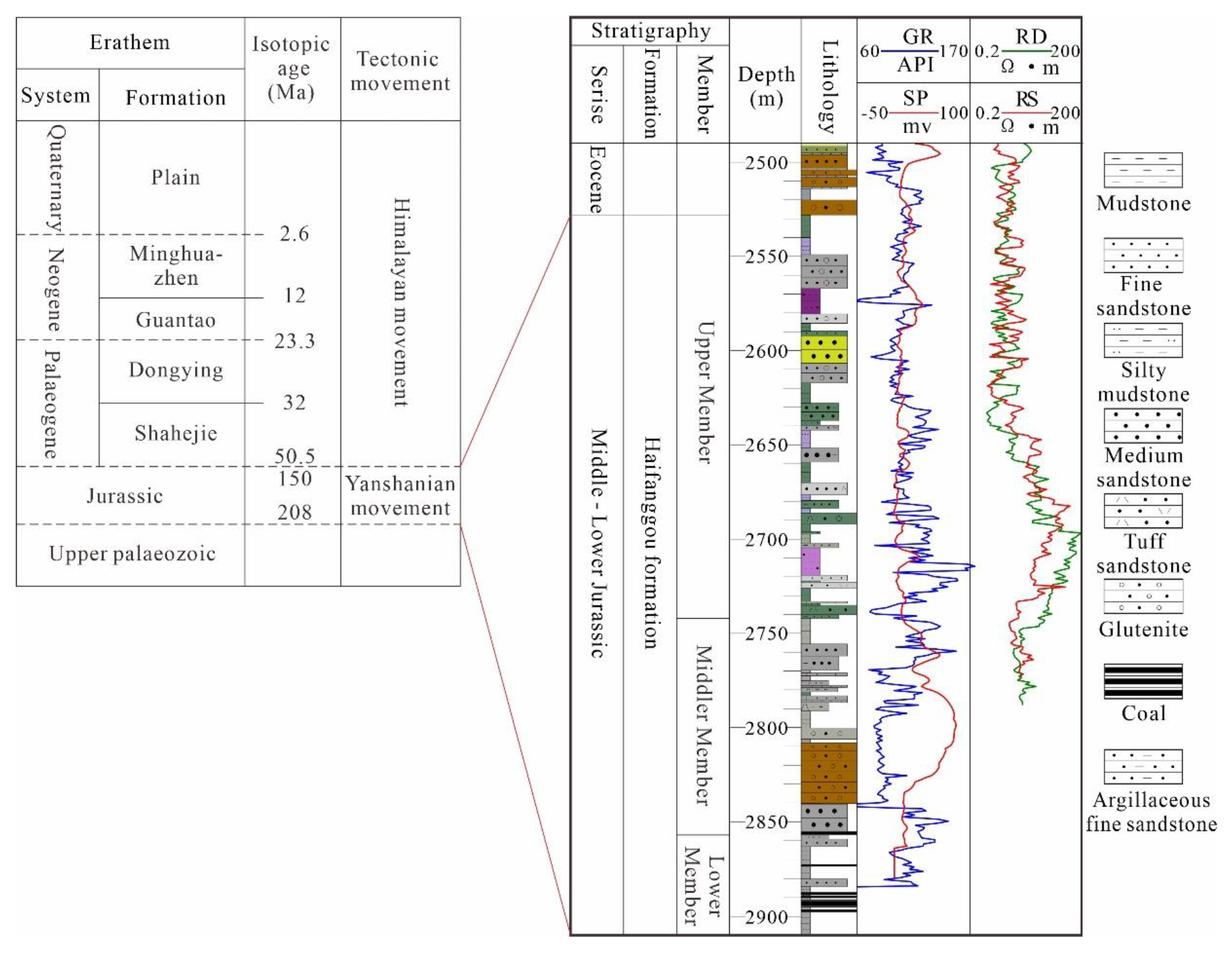




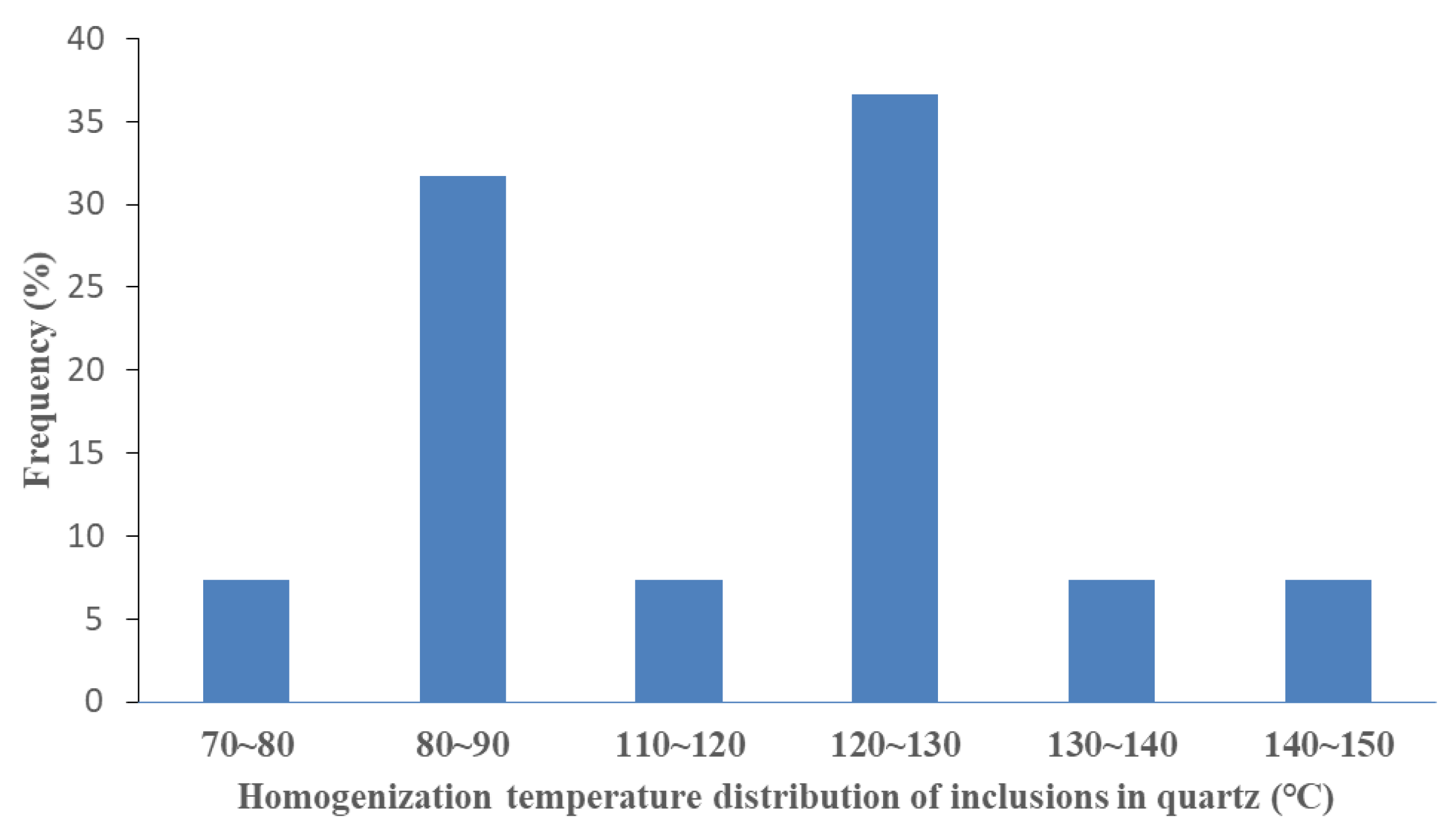




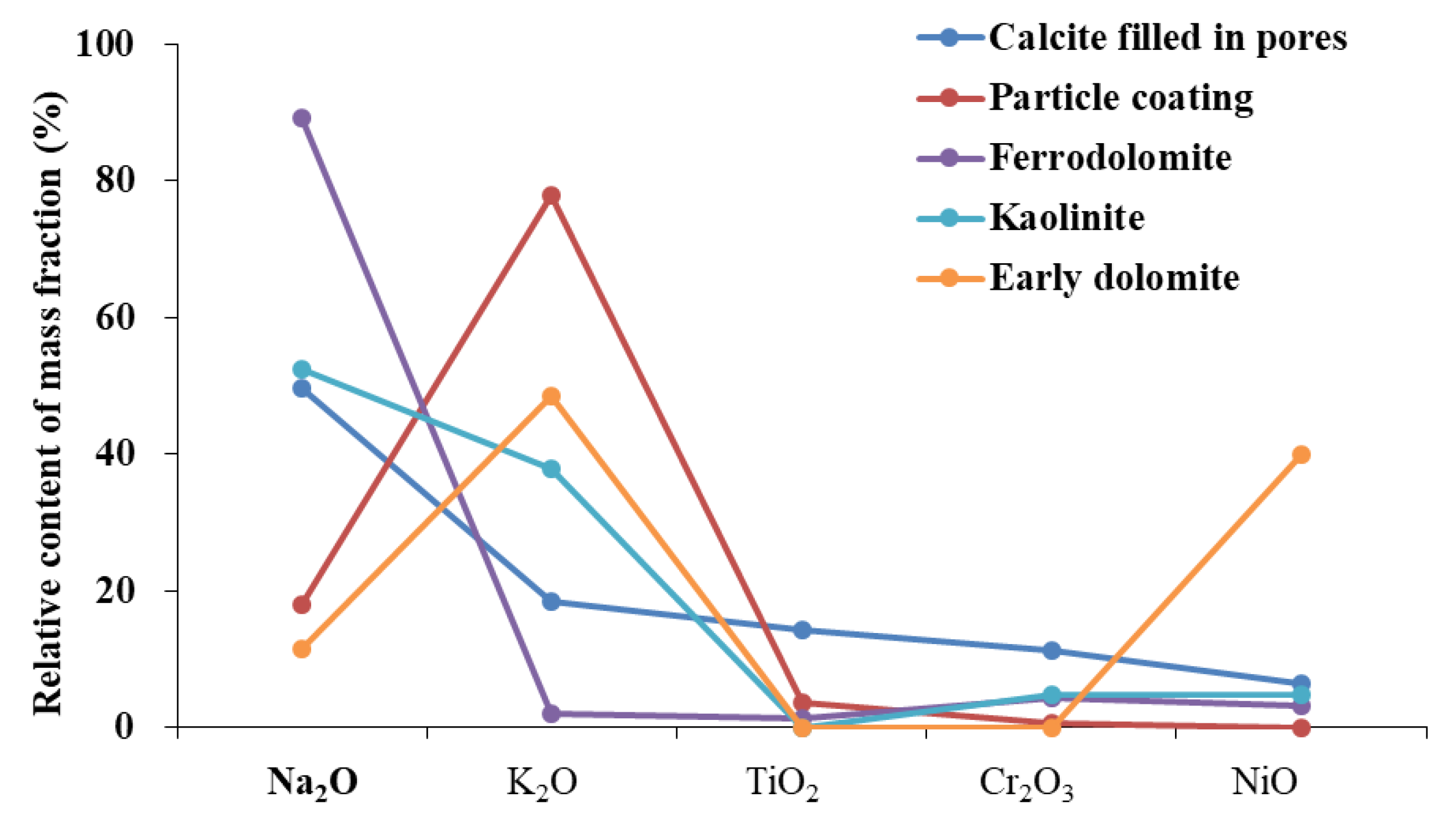
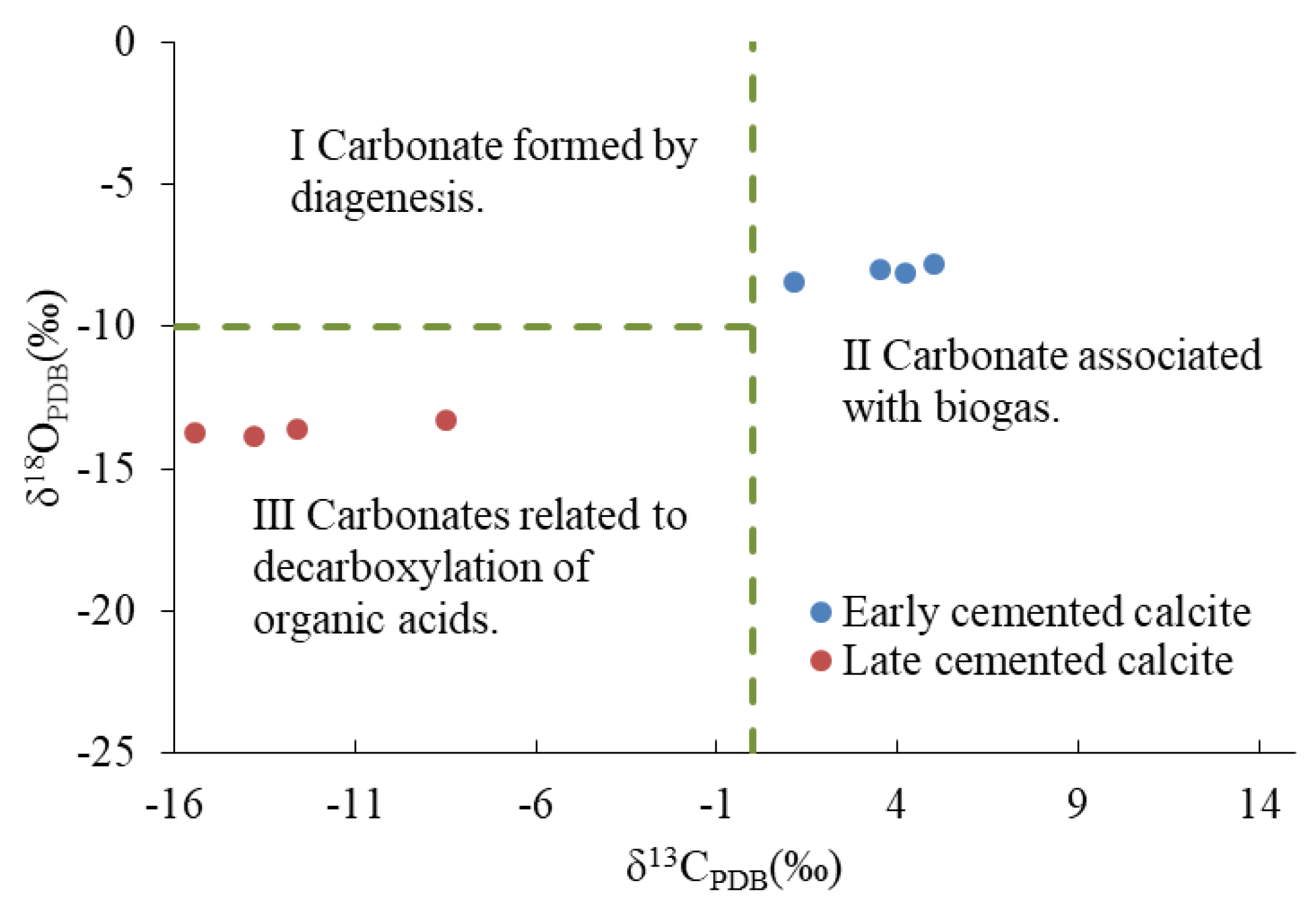

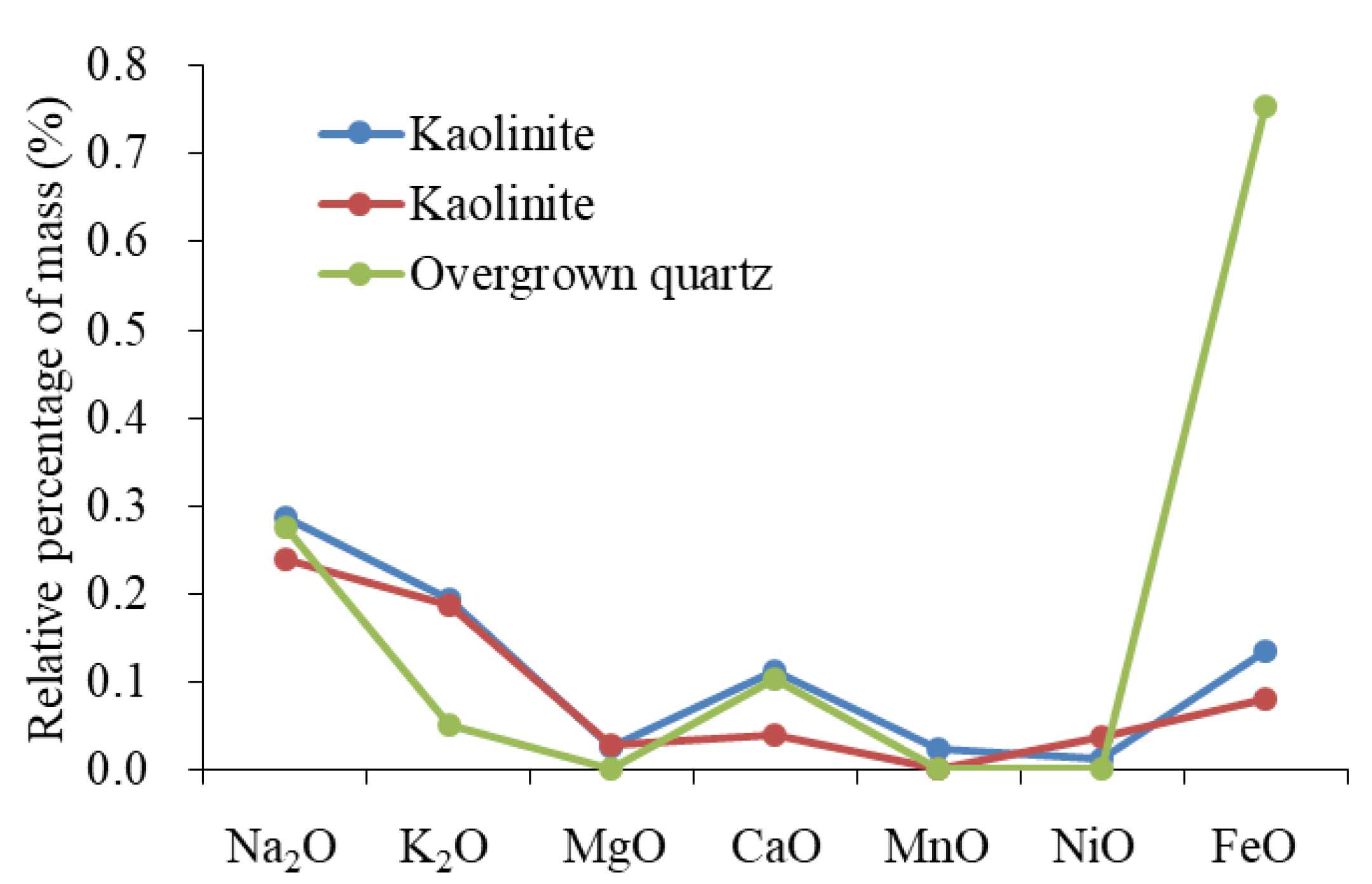
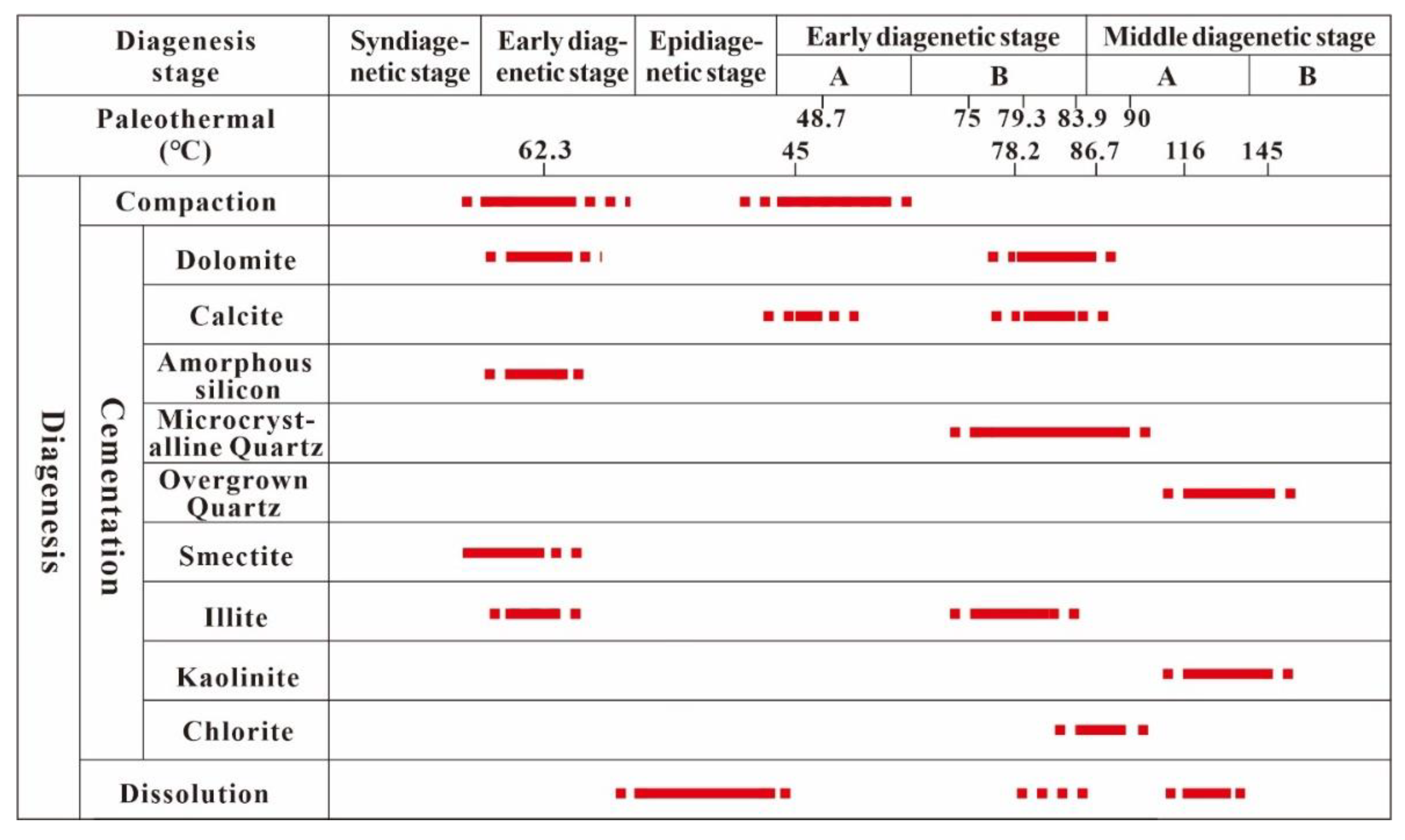
| Well | Number * | Depth (m) | Mineral Characteristic | Na2O | K2O | MnO | MgO | SiO2 | FeO | CaO | SrO | CoO | SO3 | TiO2 | Al2O3 | Cr2O3 | NiO | Total |
|---|---|---|---|---|---|---|---|---|---|---|---|---|---|---|---|---|---|---|
| Q9-3 | 1#1 | 2419 | Ferrodolomite | 1.19 | 0.00 | 0.30 | 24.00 | 0.09 | 21.44 | 52.93 | 0.00 | 0.02 | 0.03 | / | / | / | / | 100 |
| Q9-3 | 1#2 | 2419 | Ferrodolomite | 0.96 | 0.02 | 0.75 | 20.67 | 0.09 | 25.17 | 51.94 | 0.24 | 0.09 | 0.07 | / | / | / | / | 100 |
| Q9-3 | 1#3 | 2423 | Ferrodolomite | 0.39 | 0.01 | 0.63 | 22.73 | 0.35 | 20.35 | 55.41 | 0.13 | 0.00 | 0.00 | / | / | / | / | 100 |
| Q9-3 | 1#4 | 2423 | Ferrodolomite | 0.32 | 0.02 | 0.70 | 22.61 | 0.17 | 17.82 | 58.07 | 0.21 | 0.08 | 0.01 | / | / | / | / | 100 |
| Q9-3 | 2#7 | 2423 | Ferrodolomite | 1.07 | 0.00 | 0.72 | 23.81 | 0.06 | 21.71 | 52.45 | 0.12 | 0.06 | 0.00 | / | / | / | / | 100 |
| Q9-3 | 2#8 | 2423 | Ferrodolomite | 0.29 | 0.00 | 0.90 | 20.96 | 0.05 | 23.41 | 54.10 | 0.25 | 0.00 | 0.03 | / | / | / | / | 100 |
| Q9-3 | 2#1 | 2423 | Early dolomite | 0.06 | 0.04 | 0.00 | 40.07 | 0.04 | 0.11 | 59.69 | 0.00 | 0.00 | 0.01 | / | / | / | / | 100 |
| Q9-3 | 2#2 | 2423 | Early dolomite | 0.09 | 0.00 | 0.04 | 39.26 | 0.11 | 0.13 | 60.38 | 0.00 | 0.00 | 0.00 | / | / | / | / | 100 |
| Q9-3 | 1#1 | 2174 | Calcite filled in pores | 0.06 | 0.02 | 7.81 | 0.04 | 0.09 | 0.23 | 91.62 | / | / | / | 0.06 | 0.04 | 0.00 | 0.03 | 100 |
| Q9-3 | 1#2 | 2174 | Calcite filled in pores | 0.04 | 0.03 | 8.44 | 0.07 | 0.08 | 0.10 | 91.22 | / | / | / | 0.00 | 0.01 | 0.00 | 0.00 | 100 |
| Q9-3 | 1#3 | 2174 | Particle coating | 0.56 | 1.22 | 0.22 | 0.64 | 85.08 | 3.95 | 4.85 | / | / | / | 0.08 | 3.41 | 0.00 | 0.00 | 100 |
| Q9-3 | 1#4 | 2174 | Particle coating | 1.28 | 7.39 | 0.10 | 3.28 | 59.57 | 11.28 | 1.84 | / | / | / | 0.46 | 14.78 | 0.02 | 0.00 | 100 |
| Q9-3 | 2#2 | 2174 | Particle coating | 0.47 | 1.86 | 0.08 | 1.74 | 85.22 | 3.11 | 1.11 | / | / | / | 0.11 | 6.27 | 0.04 | 0.00 | 100 |
| Q9-3 | 2#3 | 2174 | Particle coating | 0.87 | 5.06 | 0.00 | 2.60 | 71.27 | 6.35 | 0.54 | / | / | / | 0.17 | 13.10 | 0.04 | 0.00 | 100 |
| Q9-3 | 2#5 | 2174 | Calcite filled in pores | 0.11 | 0.03 | 7.89 | 0.10 | 0.19 | 0.20 | 91.42 | / | / | / | 0.00 | 0.02 | 0.05 | 0.00 | 100 |
| Q9-3 | 1#1 | 2424 | Albite | 11.26 | 0.07 | 0.01 | 0.00 | 67.83 | 0.11 | 0.33 | / | / | / | 0.00 | 20.38 | 0.01 | 0.00 | 100 |
| Q9-3 | 1#5 | 2424 | Potassium feldspar | 0.87 | 14.90 | 0.00 | 0.00 | 65.10 | 0.09 | 0.01 | / | / | / | 0.01 | 19.02 | 0.00 | 0.00 | 100 |
| Q9-3 | 2#1 | 2424 | Ferrodolomite | 1.06 | 0.04 | 0.72 | 20.98 | 0.06 | 25.45 | 49.75 | / | / | / | 0.03 | 1.86 | 0.05 | 0.00 | 100 |
| Q9-3 | 2#5 | 2424 | Kaolinite | 0.29 | 0.19 | 0.02 | 0.03 | 54.02 | 0.13 | 0.11 | / | / | / | 0.00 | 45.17 | 0.03 | 0.01 | 100 |
| Q9-3 | 2#7 | 2424 | Kaolinite | 0.24 | 0.19 | 0.00 | 0.03 | 53.37 | 0.08 | 0.04 | / | / | / | 0.00 | 46.00 | 0.02 | 0.04 | 100 |
| Q9-3 | 3#1 | 2424 | Overgrown quartz | 0.03 | 0.00 | 0.00 | 0.00 | 99.74 | 0.08 | 0.01 | / | / | / | 0.00 | 0.10 | 0.04 | 0.00 | 100 |
| Q9-3 | 3#2 | 2424 | Ferrodolomite | 1.02 | 0.01 | 0.90 | 21.86 | 0.31 | 21.80 | 52.33 | / | / | / | 0.00 | 1.65 | 0.05 | 0.07 | 100 |
| Q9-3 | 3#4 | 2424 | Early dolomite | 0.01 | 0.03 | 0.06 | 42.83 | 0.10 | 0.10 | 56.84 | / | / | / | 0.00 | 0.01 | 0.00 | 0.03 | 100 |
| Well | Depth (m) | Mineral Type | δ13CPDB (‰) | δ18OPDB (‰) | Type |
|---|---|---|---|---|---|
| Q9-1D | 2434.45 | Dolomite | 3.72 | −7.56 | D1 |
| Q9-1D | 2182.1 | Dolomite | −3.08 | −10.26 | D2 |
| Q9-1D | 2183.67 | Dolomite | −3.3 | −10.66 | D2 |
| Q9-1D | 2845.75 | Dolomite | −2.56 | −10.22 | D2 |
| Q9-1D | 2848.56 | Dolomite | −2.56 | −11.26 | D2 |
| Q9-1D | 2850.32 | Calcite | 1.13 | −8.41 | C1 |
| Q9-2 | 1860.2 | Calcite | 5.02 | −7.79 | C1 |
| Q9-2 | 2317.3 | Calcite | 4.23 | −8.11 | C1 |
| Q9-3 | 2174.2 | Calcite | 3.52 | −7.97 | C1 |
| Q9-3 | 2187.21 | Calcite | −8.51 | −13.32 | C2 |
| Q9-3 | 2211.9 | Calcite | −12.59 | −13.64 | C2 |
| Q9-3 | 2218.44 | Calcite | −13.82 | −13.89 | C2 |
| Q9-3 | 2214.94 | Calcite | −15.44 | −13.72 | C2 |
Disclaimer/Publisher’s Note: The statements, opinions and data contained in all publications are solely those of the individual author(s) and contributor(s) and not of MDPI and/or the editor(s). MDPI and/or the editor(s) disclaim responsibility for any injury to people or property resulting from any ideas, methods, instructions or products referred to in the content. |
© 2023 by the authors. Licensee MDPI, Basel, Switzerland. This article is an open access article distributed under the terms and conditions of the Creative Commons Attribution (CC BY) license (https://creativecommons.org/licenses/by/4.0/).
Share and Cite
Song, X.; Lv, Z.; Zang, C.; Hao, P.; He, Y.; Zhao, W.; Qing, Y.; Ren, J. Diagenetic Evolution Mechanism of the Jurassic Tuffaceous Sandstone Reservoir in Qikou Sag, Bohai Bay Basin, East China. Minerals 2023, 13, 80. https://doi.org/10.3390/min13010080
Song X, Lv Z, Zang C, Hao P, He Y, Zhao W, Qing Y, Ren J. Diagenetic Evolution Mechanism of the Jurassic Tuffaceous Sandstone Reservoir in Qikou Sag, Bohai Bay Basin, East China. Minerals. 2023; 13(1):80. https://doi.org/10.3390/min13010080
Chicago/Turabian StyleSong, Xiuzhang, Zhengxiang Lv, Chunyan Zang, Peng Hao, Yinjun He, Wei Zhao, Yuanhua Qing, and Jie Ren. 2023. "Diagenetic Evolution Mechanism of the Jurassic Tuffaceous Sandstone Reservoir in Qikou Sag, Bohai Bay Basin, East China" Minerals 13, no. 1: 80. https://doi.org/10.3390/min13010080





